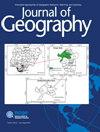Refraction Seismic Survey in Suruga Bay Using OBSs and Air-gun Sources: Increased Subsurface Velocity Structure Observed at the Northern Part of the Senoumi Bank
IF 1.8
3区 地球科学
Q1 GEOGRAPHY
引用次数: 0
Abstract
Suruga Bay is a tectonic bay that is traversed in the north-south direction by the Suruga Trough, which is considered to be a subduction boundary between the northern margin of the Philippine Sea Plate and the Eurasian Plate. In order to clarify the shape of the subducting plate boundary, seismic refraction surveys were conducted using 14 sets of pop-up type ocean bottom seismographs (OBSs) and air-guns as controlling seismic sources at a total of six survey lines in the years 2016, 2017, and 2018. The main survey lines are located along the western side, the axis of the Suruga Trough, and the Izu peninsula side of Suruga Bay; the three main lines run approximately north to south across Suruga Bay. This enables the subsurface velocity structure beneath the sea floor to be obtained. Features indicate the shape and subduction of the subducting plate boundary if the subsurface velocity structure beneath each survey line can be determined in detail. Details of the velocity structure at the western side of Suruga Bay investigated in 2016 are presented. The survey line 2016-NS is located at the Eurasian Plate side and runs about 36 km from the Senoumi Basin to off the Udo Hills at the west side of the Senoumi-kita Bank, almost parallel to the west coast of Suruga Bay. Survey line 2016-EW crosses Suruga Bay about 18 km from near Yaizu on the west coast of the bay to near Toi on the east coast. The subsurface velocity boundary is complex, and an unusual structure rises in the subsurface structure at the north side of Senoumi-kita Bank. The rising structure is connected to the Senoumi-minami Bank and the Senoumi-kita Bank, and is considered to be an uplift derived from the outer ridge uplift belt zone.用地震仪和气枪震源在骏河湾进行折射地震勘探:在Senoumi岸北部观测到增加的地下速度结构
Suruga Bay是一个由Suruga海槽横贯南北的构造湾,被认为是菲律宾海板块北缘与欧亚板块之间的俯冲边界。为明确俯冲板块边界形态,在2016年、2017年和2018年,利用14台弹出式海底地震仪(obs)和气枪作为控制震源,在6条测点上进行了地震折射调查。主要测量线位于骏河海槽的西侧、轴线和骏河湾的伊豆半岛一侧;三条主要线路大致由北向南穿过骏河湾。这样就可以得到海底下的地下速度结构。如果能详细确定每条测线下的地下速度结构,特征就能指示俯冲板块边界的形状和俯冲情况。介绍了2016年调查的骏河湾西侧速度结构的细节。2016-NS测量线位于欧亚板块一侧,从Senoumi盆地到Senoumi-kita Bank西侧的Udo Hills外约36公里,几乎与骏河湾西海岸平行。测量线2016-EW穿过骏河湾约18公里,从海湾西海岸的Yaizu附近到东海岸的Toi附近。地下速度边界复杂,在七原北滩北侧的地下构造中有一个不寻常的隆起构造。该隆起构造与上南滩和上北滩相连,被认为是由外脊隆起带衍生出来的隆起。
本文章由计算机程序翻译,如有差异,请以英文原文为准。
求助全文
约1分钟内获得全文
求助全文
来源期刊

Journal of Geography
GEOGRAPHY-
CiteScore
4.90
自引率
6.50%
发文量
12
期刊介绍:
Journal of Geography is the journal of the National Council for Geographic Education. The Journal of Geography provides a forum to present innovative approaches to geography research, teaching, and learning. The Journal publishes articles on the results of research, instructional approaches, and book reviews.
 求助内容:
求助内容: 应助结果提醒方式:
应助结果提醒方式:


